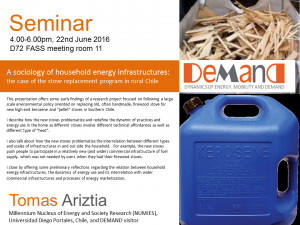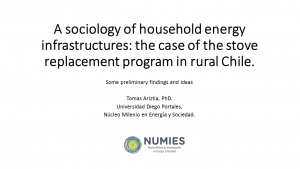This presentation offers some early findings of a research project focused on following a large scale environmental policy oriented on replacing old, often handmade, firewood stove for new high-end kerosene and “pellet” stoves in Southern Chile. The main aim of this policy is to reduce air pollution.
The presentation focuses on discussing some preliminary empirical findings as well as on introducing some broader theoretical insights. At the empirical level, I describe some aspects of in the stove replacement process. I focus specifically on two elements. First, I describe how the new stoves problematize and redefine the dynamic of practices and energy use in the home as different stoves involve different technical affordances as well as different type of “heat”. More concretely, I describe how the installation of kerosene stove not only redefine and challenge some household existing practices in its spatiotemporal organization and components -such as clothes drying- but also implies the rise of new heating practices related to the technical affordances of the new stoves.
Second, we describe how the new stoves problematize the interrelation between different types and scales of infrastructures in and out the household. In particular, we describe how the new stoves push beneficiaries to participate in a relative new (and wider) commercial infrastructure of fuel supply, which was not needed by users when they had their firewood stoves.
We close by offering some preliminary reflections regarding the relation between household energy infrastructures, the dynamics of energy use and its interrelation with wider commercial infrastructures and dynamics of energy marketization.
Report
Tomas Ariztia, a DEMAND visitor from Chile, talked about a current project on home heating – focusing on the introduction of ‘smart’ kerosene stoves to replace air-polluting wood-burning stoves. This programme, promoted by the government, involves changes in many dimensions at once: those who benefit from the new stoves have to buy fuel and can no longer rely on free supplies of wood/scrap. The new, highly controllable stoves provide a different kind of heat – warming and circulating air. The stoves need an electricity supply – to power and manage the controls and sensors, and they have special requirements in terms of location: near an external wall. In addition, they represent a significant intervention in the wider ‘ecology’ of heating devices including hot water bottles and blankets, and in the practicalities and timing of heating through the day. There were lots of really interesting parallels and differences compared to the introduction of full central heating in the UK (e.g. the role of the TV, the weather, methods of cooking), and links to wider DEMAND ideas about how infrastructures and practices constitute each other.
Wednesday 22nd June 16.00-18.00, D72/MR11 FASS, Lancaster University



